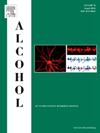Understanding drunkorexia behaviors among college students using the theory of planned behavior
IF 2.9
4区 医学
Q3 PHARMACOLOGY & PHARMACY
引用次数: 0
Abstract
Drunkorexia refers to high-risk behaviors that involve the intersection of disordered eating behaviors and risky alcohol consumption. This study utilized the extended Theory of Planned Behavior (TPB) to identify potential psychosocial factors that contribute to drunkorexia among students (484 undergraduate students) from a midwestern Mid-sized university. This cross-sectional study used online surveys designed to measure various drunkorexia-related behaviors including alcohol consumption, calorie restriction, excessive exercise, and purging utilizing antecedents of the TPB. About one-fourth of participants reported engagement in drunkorexia. The extended TPB model reported strong predictive validity for intention for calorie restriction, excessive exercise, and purging with instrumental attitudes and capacity being significant predictors for all three behaviors. Findings provide more profound insight regarding patterns of drunkorexia that could inform future theory-based interventions to address drunkorexia among college students.
用计划行为理论理解大学生醉酒行为。
暴饮暴食是指饮食紊乱和危险饮酒的高危行为。本研究利用扩展的计划行为理论(TPB)来确定导致美国中西部一所中等规模大学学生(484名本科生)醉酒的潜在社会心理因素。这项横断面研究采用在线调查的方式,旨在测量各种与醉酒有关的行为,包括饮酒、卡路里限制、过度运动和利用TPB前因进行排毒。大约四分之一的参与者报告说自己有过醉酒的经历。扩展的TPB模型报告了对卡路里限制,过度运动和净化的意图的强预测有效性,工具性态度和能力是这三种行为的重要预测因子。研究结果提供了关于醉酒模式的更深刻的见解,可以为未来基于理论的干预措施提供信息,以解决大学生醉酒问题。
本文章由计算机程序翻译,如有差异,请以英文原文为准。
求助全文
约1分钟内获得全文
求助全文
来源期刊

Alcohol
医学-毒理学
CiteScore
4.60
自引率
4.30%
发文量
74
审稿时长
15.6 weeks
期刊介绍:
Alcohol is an international, peer-reviewed journal that is devoted to publishing multi-disciplinary biomedical research on all aspects of the actions or effects of alcohol on the nervous system or on other organ systems. Emphasis is given to studies into the causes and consequences of alcohol abuse and alcoholism, and biomedical aspects of diagnosis, etiology, treatment or prevention of alcohol-related health effects.
Intended for both research scientists and practicing clinicians, the journal publishes original research on the neurobiological, neurobehavioral, and pathophysiological processes associated with alcohol drinking, alcohol abuse, alcohol-seeking behavior, tolerance, dependence, withdrawal, protracted abstinence, and relapse. In addition, the journal reports studies on the effects alcohol on brain mechanisms of neuroplasticity over the life span, biological factors associated with adolescent alcohol abuse, pharmacotherapeutic strategies in the treatment of alcoholism, biological and biochemical markers of alcohol abuse and alcoholism, pathological effects of uncontrolled drinking, biomedical and molecular factors in the effects on liver, immune system, and other organ systems, and biomedical aspects of fetal alcohol spectrum disorder including mechanisms of damage, diagnosis and early detection, treatment, and prevention. Articles are published from all levels of biomedical inquiry, including the following: molecular and cellular studies of alcohol''s actions in vitro and in vivo; animal model studies of genetic, pharmacological, behavioral, developmental or pathophysiological aspects of alcohol; human studies of genetic, behavioral, cognitive, neuroimaging, or pathological aspects of alcohol drinking; clinical studies of diagnosis (including dual diagnosis), treatment, prevention, and epidemiology. The journal will publish 9 issues per year; the accepted abbreviation for Alcohol for bibliographic citation is Alcohol.
 求助内容:
求助内容: 应助结果提醒方式:
应助结果提醒方式:


